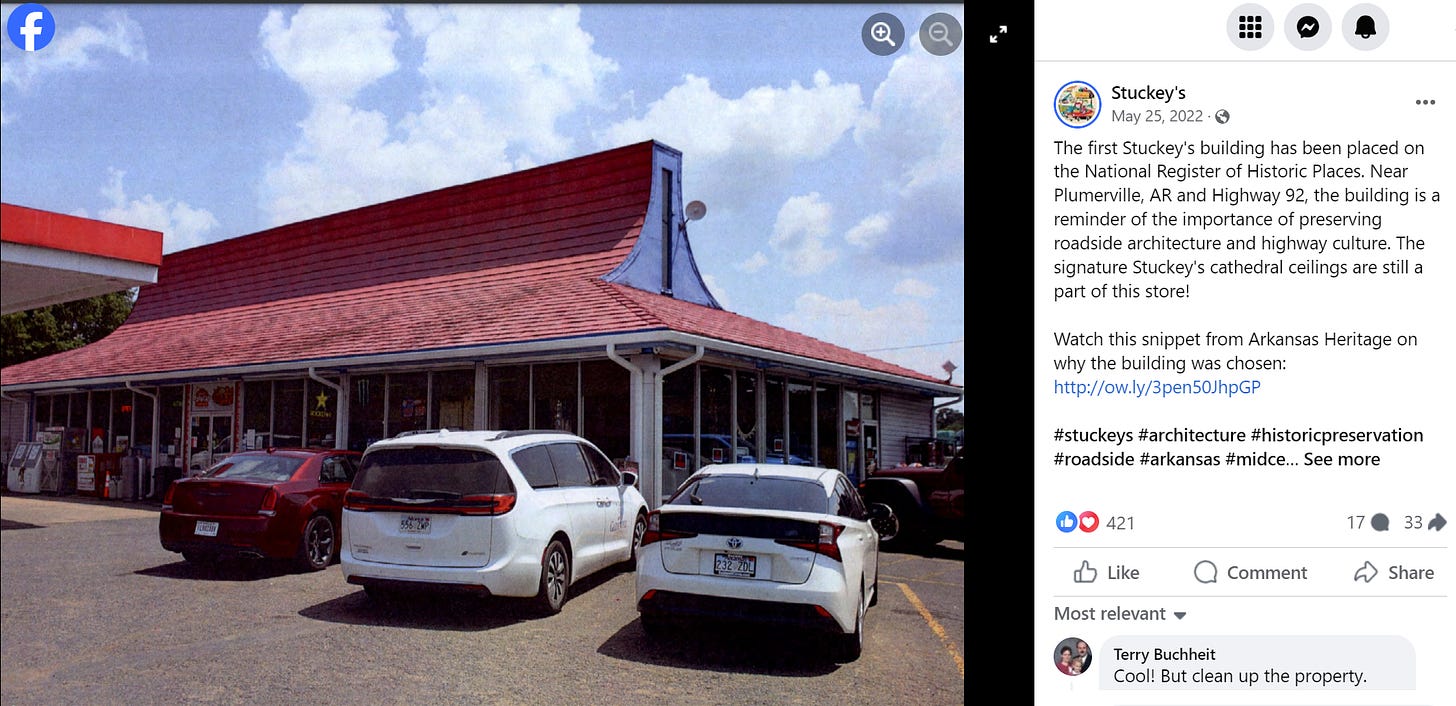We’re out in the remote and sparsely populated Virginia Eastern Shore today:
A more recent image from the other side:
This is a Stuckey’s. This is not only the last old-school location on the Eastern Shore, as this nice local write-up states. It’s the only Stuckey’s of any description left in the whole state of Virginia, according to the chain’s online store locator. I wrote once about a former Stuckey’s in Virginia—Middletown, out near Winchester—and what happened to the building is one of the quirkiest examples of a commercial building being reused or adapted that I’ve ever seen. You have to take a look at it.
Stuckey’s is a mostly Southern/Southeastern convenience store chain, known for its pecan confections, which dates back to the 1930s. It changed ownership in the 1960s, hit a rough patch in the 1970s, and slowly dwindled in number until it was re-purchased by the founder’s son in the 1980s, and then purchased by the founder’s granddaughter, Stephanie Stuckey, just a few years ago.
Under Stephanie Stuckey’s tenure, the company’s products have gotten much wider distribution, and the 1980s reboot consisting of “Express” mini-locations has continued. What’s interesting to me is that there is this relatively small contingent of legacy stores still in operation, which never closed during the hard times and survived long enough to once again exist under the umbrella of the founding family.
This isn’t, or wasn’t, at all guaranteed. There are cases of chains having downturns where they never come back—Howard Johnson’s restaurant. And there are cases where the legacy locations are split off from the IP, such that there end up being more than one claimant to the brand identity—Arthur Treacher’s, which has a fascinating, byzantine corporate story. There are “last locations” of erstwhile chains which basically survive the actual company of which they were once a part—like, I like to say, a Catholic parish persisting after the abolition of the papacy.
Like Howard Johnson’s, there were several similar iterations of the iconic brand-centric structure, of which the model in Mappsville was earlier. (The model in Middletown, Virginia, linked above, was later.) But as with many of these early roadside chains, the architecture sometimes differed from the standard brand model. If you look up “old Stuckey’s locations,” you’ll see a lot of small variations in the old buildings.
Here’s another example of the Mappsville-style building, in Florida. It isn’t a Stuckey’s anymore, though. There aren’t any left in Florida either, according to the locator.
And here’s one of the later iterations of the structure, from the company’s Facebook page:
So while there’s only one Stuckey’s company, there are two slightly divergent incarnations of it. And as with almost all chains that reached any real size, a number of the old structures live on outside the company.
No deeper point here—just a little bit of American roadside delight.
Related Reading:
Pecan Log Rolls and Hotel Rooms
Dine Like It’s 1950 in Warrenton, Virginia
Thank you for reading! Please consider upgrading to a paid subscription to help support this newsletter. You’ll get a weekly subscribers-only piece, plus full access to the archive: over 1,000 pieces and growing. And you’ll help ensure more like this!








I think there are still a couple here in NC, but haven’t been to one.
My parents retired in '79, and moved from suburban Philadelphia to Virginia Beach, so passed by that Stuckeys many times. Mother made a point of stopping there, she appreciated their clean restrooms. Glad it's still there.